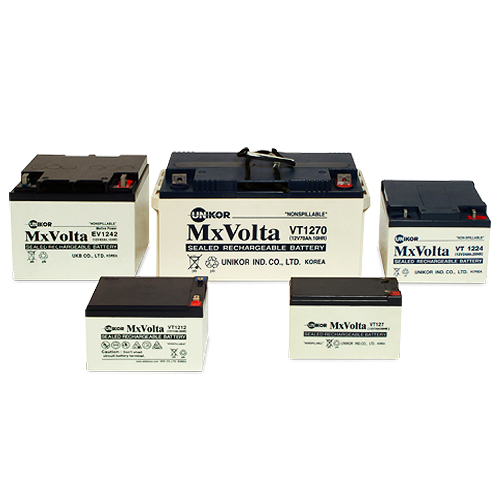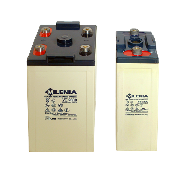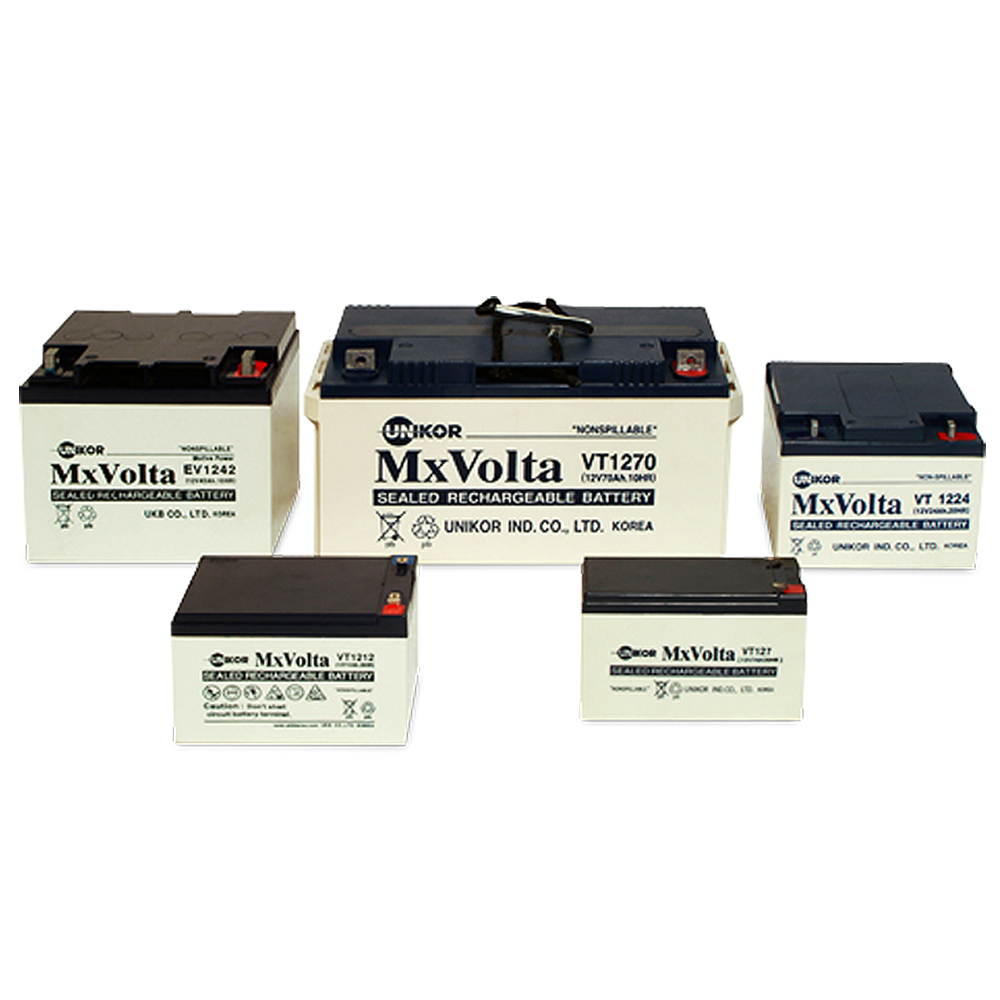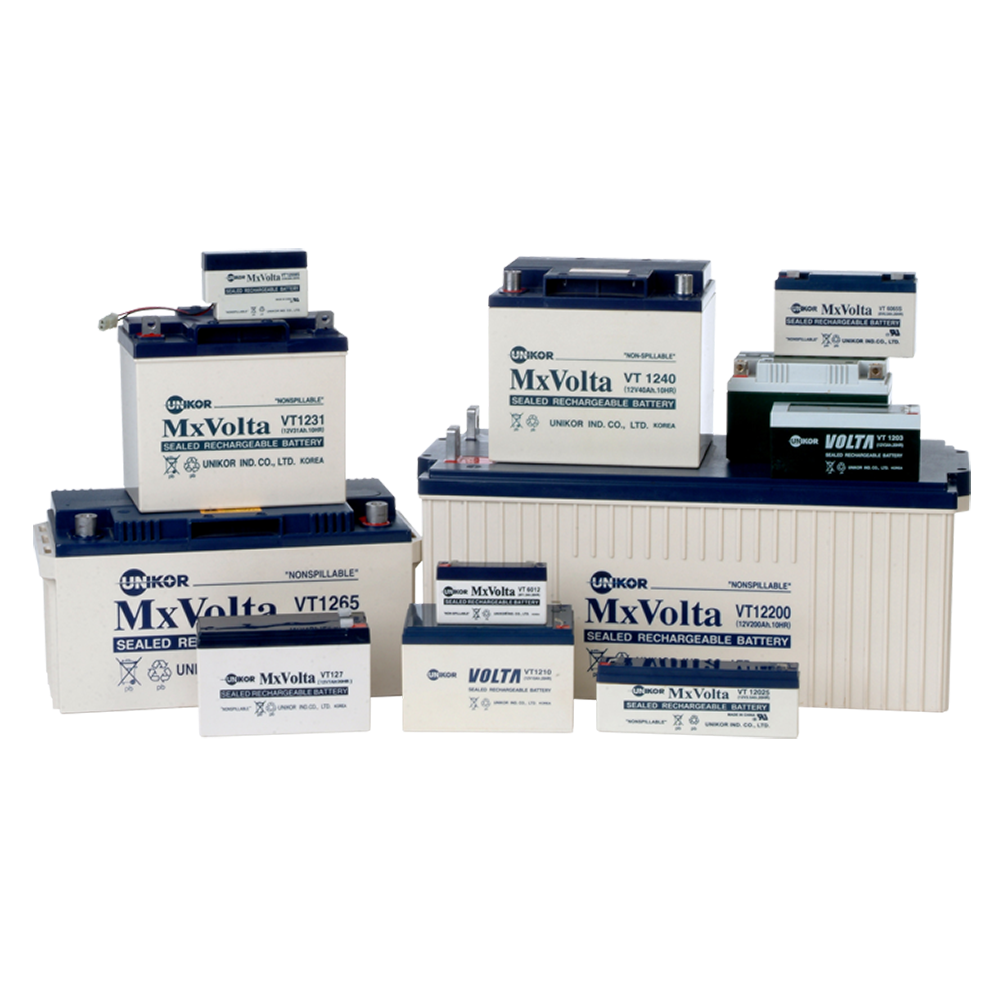ITEM SPECIFICS
-
Brand
Model VT 6V 12VMxVolta
-
origin
Republic of Korea
-
Size(Capacity)
up to 250Ah
-
Weight
up to 70kg
-
Color
White container
-
Features
lead acid battery
-
Condition
Brand new
-
age-appropriate
Minimum 10 years
PRODUCT DESCRIPTION
Applications
VT series VRLA (Valve Regulated Lead Acid) technic sealed batteries are specially designed for cyclic and standby use, where a weight, available space, and durability count.
Features
► Capacity range up to 250AH
► Voltage 2V, 6V and 12V
► Low self-discharge rate : less than 3% per month
► High sealed efficiency : more than 98%
► Wide operation temperature : -20°C to 45°C
► Long design life and good discharge & charge performance
► Plate: Positive and Negative grid plate use Pb-Ca alloy
► Container: ABS resin for durability against impact and shock proof
► Compliance IEC 61056
► Approved ISO 9001, ISO 14001, UL and CE
Cyclic Life
There are a number of factors that affect the length of cyclic life of a VT battery. Major factors are the ambient operating temperature, the discharge rate, the manner in which the battery is recharged, of which the most important is the depth of discharge.
Float Life
6V, 12V Series
VT batteries are designed to operate in standby(float) use up to 5 years on a normal service condition in which float charge voltage is maintained between 2.25 and 2.30 volts per cell in an ambient temperature of approximately 25°C(77°C). Figure 7 shows the float life characteristics of VT batteries when discharged once three(3) months up to 100% depth of discharge.In normal float use, where charging voltage is maintained 2.25 to 2.30 volts per cell, gas generated inside a VT battery is recombined into the negative plates, and return to water content of the electrolyte. Electrical capacity therefore is not lost due to “drying-up” of the electrolyte. Through gradual corrosion of the electrodes, the battery will eventually lose capacity and come to an end of life. It should be noted that the process will be accelerated by higher ambient operating temperatures and/of higher charging voltages.When designing a float system, one must bear in mind that length of life will be directly affected by the number of discharge cycles, the depth of discharge, the ambient temperature, and the charging voltage.
► Capacity range up to 250AH
► Voltage 2V, 6V and 12V
► Low self-discharge rate : less than 3% per month
► High sealed efficiency : more than 98%
► Wide operation temperature : -20°C to 45°C
► Long design life and good discharge & charge performance
► Plate: Positive and Negative grid plate use Pb-Ca alloy
► Container: ABS resin for durability against impact and shock proof
► Compliance IEC 61056
► Approved ISO 9001, ISO 14001, UL and CE
Cyclic Life
There are a number of factors that affect the length of cyclic life of a VT battery. Major factors are the ambient operating temperature, the discharge rate, the manner in which the battery is recharged, of which the most important is the depth of discharge.
Float Life
6V, 12V Series
VT batteries are designed to operate in standby(float) use up to 5 years on a normal service condition in which float charge voltage is maintained between 2.25 and 2.30 volts per cell in an ambient temperature of approximately 25°C(77°C). Figure 7 shows the float life characteristics of VT batteries when discharged once three(3) months up to 100% depth of discharge.In normal float use, where charging voltage is maintained 2.25 to 2.30 volts per cell, gas generated inside a VT battery is recombined into the negative plates, and return to water content of the electrolyte. Electrical capacity therefore is not lost due to “drying-up” of the electrolyte. Through gradual corrosion of the electrodes, the battery will eventually lose capacity and come to an end of life. It should be noted that the process will be accelerated by higher ambient operating temperatures and/of higher charging voltages.When designing a float system, one must bear in mind that length of life will be directly affected by the number of discharge cycles, the depth of discharge, the ambient temperature, and the charging voltage.
PAYMENTS DETAILS
This supplier supports payments for offline orders
- Telegraphic Transfer : T/T
- Name : JIMMY KIM
SHIPPING
Shipping from :
Republic of Korea
- 70 Dusan-ro (08584)
UKB(unikor battery) CO.,LTD
The person in charge
Jimmy KimAddress
70 Dusan-ro, Geumcheon-gu, Seoul (08584)
Introduction
Since establishment in 1995, UKB has been manufacturing and exporting a wide range of high-quality industrial batteries for UPS & Telecommunications, traction batteries for golf cars, forklifts, sweepers & electric vehicles to approximately 40 countries around the world including the core patented product tubular type deepcycle battery with superior performance. UKB has successfully supplied to well-known japanese electric power companies such as Tokyo, Kyushu and Kansai Electric Power Company.
-
- Business Type :
- Manufacturer
-
- Main Product :
- Industrial batteries
-
- Established :
- 2016-04-03
-
- Total Annual Revenue :
- 4~5 billion (KRW)
-
- Total Employees :
- 11~50 people
COMPANY ENVIRONMENT
Please suggest a variety of your ideas such as design, impact, enhancements, etc
Captcha Required
Please enter the text on the left image to prevent automatic input.
0 / 4000
질문이 없습니다.
CUSTOMER REVIEWS (0)
TRADE EXPERIENCE
-
- Total revenue
- 4~5 billion (KRW)
-
- Total export revenue (previous year in USD)
- 3,108
-
- Number of foreign trade employees
- 11~50 people
COMPARISON TO SIMILAR ITEMS more
- No Items
- supplier level
-
 PLATINUM
PLATINUM
- UKB(unikor battery) CO.,LTD Seller's Store
- Seller's Store url
- Response Level
★ ★ ★ ★ ★

- Supplier Level
★ ★ ★ ★ ★

- Transaction Level
★ ★ ★ ★ ★





















